
 Maya Meade | Editor-in-Chief backdropmag@gmail.com
Maya Meade | Editor-in-Chief backdropmag@gmail.com


 Maya Meade | Editor-in-Chief backdropmag@gmail.com
Maya Meade | Editor-in-Chief backdropmag@gmail.com
My name is Maya Meade and I am the editor-in-chief of Backdrop magazine. I have poured my heart and soul into this publication since my freshman year, emphasizing diversity and trying to incorporate it into my writing as a student of color at a primarily white publication and institution. As a third-year journalism student studying political science, political communication and women’s, gender and sexuality studies, I feel strongly about informing the Ohio University and Athens communities on a variety of diverse and inclusive topics.
As a publication, we have faced many challenges in the last year, including having an entire staff made up of students that hardly knew each other and producing everything from the comfort of our homes. The transition from virtual life to in-person activities has been difficult for all of us as we battle with our comfort levels and the need to work in a shared space.
In this issue, junior writer Abby Neff investigated with senior Eric Boll from The New Political about the potential occurrence of a campus shooting at OU (pg. 18). This feature explores how our local police departments prepare to protect our community and ways for people to protect themselves.
Freshman writer McKenna Christy spoke to the founder of the Ohio Pawpaw Festival and explored the history of the native fruit and how it has affected the indigenous people living in Southeast Ohio (pg. 22). I am incredibly proud of the work that she has done as one of our newest Backdrop members and her feature provides a rich history to the pawpaw that so many people have come to love.
Managing editor Helen Widman created a fun and healthy baked oats recipe (pg. 16) in addition to all of the amazing work she did editing each story and assisting me with production. She is a great asset to our team and we wouldn’t have been able to publish this issue without her.

I am so thankful for the opportunity to work with our staff and very excited to share this issue with all of our readers. We will continue to work hard as journalists to make the Backdrop alumni proud and set a good example for all future Backdroppers. I hope this issue inspires you to keep supporting student journalism and teaches you something new as we continue to publish each issue.
Best,

Backdrop Magazine is an award-winning, student-run magazine aimed at covering current events and culture with OU and Athens as our "Backdrop." We are currently recruiting more people to join our amazing staff. We have positions available for:
• Writers
• Photographers
• Designers
• Social Media Content Creators
• And more!
If you're interested in joining our team, email backdropmag@gmail.com

EDITOR-IN-CHIEF MAYA MEADE
MANAGING EDITOR HELEN WIDMAN
WEB EDITOR JOSIE DONOHUE
COPY CHIEF LILY ROBY
COPY EDITORS GABRIELLA HAYES, HAILEY YOUNG
ASSOCIATE EDITORS DYLAN BENEDICT, AYA CATHEY, MCKENNA CHRISTY, SOPHIA ENGLEHART, CAROLINE GILLEN
MARKETING DIRECTOR MICKEY RUIZ
SOCIAL MEDIA DIRECTOR SARAH TODACK
CONTRIBUTING WRITER ERIC BOLL
CREATIVE DIRECTOR LAINEY DOUGLAS
ART DIRECTOR BROOKE GARRETT, CJ HERR
DESIGNERS EMME BOWE, LAINEY DOUGLAS, BROOKE GARRETT, CJ HERR, RACHEL RECTOR, JOSIE RILEY
PHOTO EDITOR ELLIE HABEL
PHOTOGRAPHERS DYLAN BENEDICT, JESSICA BREWER, JACOB DURBIN, ELLIE HABEL
WRITERS RORY BALL, AYA CATHEY, MCKENNA CHRISTY, JOSIE DONOHUE, SOPHIA ENGLEHART, CAROLINE GILLEN, ABBY NEFF, MAGGIE VAN FLEET, MIA WALSH
Send

PREPARING FOR THE UNIMAGINABLE
Campus officials and law enforcement share their plan for an active assailant crisis. . .
CELEBRATING THE PAWPAW AND ITS PAST
To many in the southeastern Ohio region, the pawpaw is cherished and adored. To Indigenous tribes, it is a reminder of lost food practices.. 22
Student organizations are here to build community . POWER/GAMMA keeps ours safe through peer-to-peer education .
BY MIA WALSH | ILLUSTRATIONS BY RACHEL RECTORPOWER/GAMMA, or Promoting Ohio University Wellness, Education and Responsibility/Greeks
Advocating the Mature Management of Alcohol, promotes health through their peer-to-peer programming at Ohio University. POWER/GAMMA members and committees meet weekly to collaborate on programs. POWER/GAMMA is a resource for topics such as sexually transmitted infections (STIs), nutrition, responsible alcohol consumption, sexual assault, bystander intervention and more to spread awareness and help educate students. Mady Nutter, a senior studying journalism, fulfills the roles of social media manager and co-head of the Sexual Health and Relationships committee. Backdrop sat down with Nutter to learn more about the benefits of POWER/GAMMA.
my peers who is just out there trying to help them and keep everyone safe. POWER/GAMMA is about protecting your Bobcat family at all times. Peer health educators are there to do that. They’re there to spread the information that you need to know in order to be safe, regardless of what kind of choices or decisions you’re making. We’re not there to tell anyone what to do. We’re just there to tell people how to do things safely if they’re going to do it at all, because not equipping people with that information is what gets people hurt.
POWER/GAMMA is an on-campus peer health education organization. Basically, what we do is we program to people who are our peers. POWER/GAMMA really is a huge resource for this campus. Since it is peer-to-peer education, there’s not this aspect of anyone telling you what to do. It’s really like peer health recommendations. It’s more of like when you’re in that room, it’s not like I feel like I’m some kind of teacher as a peer health educator. I’m just like one of
Freshmen are introduced to POWER/GAMMA pretty early on through Choices. A lot of people think Choices is just like Alcohol EDU, but really, it is so much more. It’s discussions of consent and bystander intervention. Of course, there is really important info on alcohol since a lot of people think that OU has this reputation of being some crazy party school, but the truth is that we actually have a very large healthy majority. So I think students should seek out POWER/GAMMA for that kind of info alone, especially once they get introduced to us through Choices. We also have other services as well, like latex demos and latexfree and nonlatex condoms. Our latex [session] includes
internal and external condoms and dental dams. So we do have that offered and we can give you free latex after we do a condom demo for you or just like show you how to use latex, then you can take it. We also do referrals for contraceptive counseling and HIV prevention. We have this event called “Get Yourself Tested.” That’s where we offer free STI testing. So that’s also a huge resource on campus. That was the first place that I got STI tested, and I think it’s just really important to normalize things like taking care of yourself, and how have you taken care of yourself and your health, especially in the context of STI testing. I think we’re a great resource and, you know, colleges, you’re coming into being an adult and learning how to take care of yourself, and what better organization to reach out to than a peer health education organization to help you with that.
“This organization connects you to so many incredible people and passionate educators.”
MADY NUTTER
SOCIAL MEDIA MANAGER & CO-HEAD OF THE SEXUAL HEALTH & RELATIONSHIPS COMMITTEE
Becoming a peer health educator was probably one of the best decisions I [made] at Ohio University. This organization connects you to so many incredible people, and passionate educators. Knowing those people has been one of the greatest pleasures of my time at Ohio University. You’re connected not only to these people but to resources to other organizations on campus that we interact with all the time. If you want to get well-connected, you should join POWER/ GAMMA. We’re just all a bunch of Peer Health Education nerds. Another thing I want them to know is that you don’t have to be one kind of peer health educator, you can really make this your own. I’m super interested in sexual health and wellness, so I hone in on those things more so than my peers who might hone in on Alcohol EDU or smoking or vaping or tobacco use. You don’t have to be any one type of educator, we have our different committees like alcohol and other drugs, general health and wellness, sexual health and wellness, stuff like that. Really, you can do whatever you want with it. We all have our little specialties and even if you have a similar interest to someone else, that typically becomes the person that you collab with on a lot of programs. I love that. It really is a great org.
The course has changed a couple of times over the years and just kind of fluctuates year to year because it is a peer class and we’re doing it through a certification that’s entirely separate from the school through NASPA (National Association of Student Personnel Administrators). When I did it, it was just like two classes a week. The workload isn’t anything crazy. It’s a really collaborative class. When you’re in class, you’re going through the programs that you’re going to be teaching someday. So you’re in the class taking a lot of notes not just on what the program is, but on how you’re going to program it. I think that’s interesting.
We have Safe and Sexy. It’s a sexual health and wellness fair that we have on campus. Usually, it is around Valentine’s Day. This year, we got to do it in the spring outside. That’s a really cool event that we do that pulls a lot of people. It’s like kind of carnival-style, and there’s usually games and prizes and stuff like that. We also have Safe Spring Break, which obviously we haven’t gotten to do here, but usually, that’s when we would have [it], the week before spring break. We would table each day with a new topic or something like that. b
Applications to join POWER/GAMMA can be found on their Bobcat Connect page. Those interested can schedule a program from POWER/GAMMA through the Ohio University Health Promotions portal online. The POWER/GAMMA Instagram is @powergamma_ou which has links to access Bobcat Connect and more ways to get involved.
There haven’t always been support systems to provide the necessary services for LGBTQ students to feel comfortable in all spaces. However, The LGBT Center at Ohio University, located on the third floor of Baker University Center, is paving the way to be one of those environments for students in the LGBTQ community.
The center is available to everyone, including students, staff, faculty, alumni and community members where they are granted access to “… support, consultation, education and connection,” according to Micah McCarey, the LGBT center director.
From Monday to Friday, 8 a.m. to 5 p.m., the center’s doors are open and McCarey, among other leaders, work to create activities that promote and celebrate diversity. The team wants everyone to see the value in inclusivity and to engage in the process of learning the prized differences in each of us.
“… As an OHIO graduate who benefited from the support of the LGBT Center and various LGBTQ+ groups during my undergrad days, it’s been inspiring to see [an] understanding of gender, sexuality and romantic attraction improve over the decades. We want people to feel safe and affirmed on campus and in the local communities that encapsulate our campuses,” McCarey says.
Progress in the understanding of gender and sexuality, as McCarey describes, should be occurring in all organizations and systems, not just in the ones solely dedicated to educating on these subjects. Therefore, no matter what organization someone wants to take part in, their representation is crucial.
“I decided to take on the role of LGBT Affairs Commission of Student Senate to make sure queer voices are represented in policy decisions and university programming,” explains junior Luvina Cooley, who is studying anthropology with a focus in both media and queer studies. “We’re focusing on intersectional advocacy, and we welcome any[one] interested to join the commission. Our commission plans Ohio University’s annual Pride Week activities in the spring of each academic year.”
Getting involved is the first step to finding safe spaces as well as ensuring LGBTQ voices are represented. While safe spaces are different for everyone, they can become crucial during overwhelming situations in college. Starting a new school year for the first or even for the fourth time can be a lot to handle, but as Mia Walsh, a sophomore studying journalism and the treasurer of Spectrum+, puts it, “college can be the first time that many queer folks are able to be their true selves.”
Spectrum+ is a student-run organization for members of the LGBTQ community and allies. The organization ensures that its members don’t need to worry about their safety while being their authentic selves. Spectrum+ strives to help its members feel more relaxed and validated.
“We meet every other week and just hang out. We plan on having game nights, movie nights, and have even just been getting lunch together in between classes,” Walsh says. “We have a GroupMe which we chat in for fun and to discuss meetings. Activism and education about the LGBTQ community are amazing and necessary, but this is a very low-key, low commitment group where we just hang out with each other.”
There is a link to join the organization’s GroupMe on their Instagram, @ouspectrumplus, or those who are interested can email Walsh, @mw508419@ohio.edu, to get connected.
Another student-run organization on campus seeks to center the voices of transgender and gender expansive folks. The Trans Student Group hosts an environment for transgender voices to be heard “openly and freely,” sophomore Carmen Szukaitis, the president of the group, who is studying womens, gender and sexuality studies with a minor in journalism, says.
“Speaking from experience, sometimes living as a trans person in a cisgender dominated society can be extremely difficult and uncomfortable," Szukaitis says. "Having this group gives me a sense of support and security because it
‘‘Having this group gives me a sense of support and security because it shows me that I’m not alone and that we are all in this togther.”
CARMEN SZUKAITIS THE TRANS STUDENT GROUP PRESIDENT
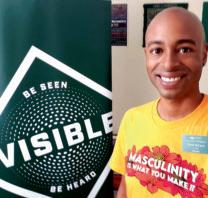
shows me that I’m not alone and that we are all in this together.”
Szukaitis encourages people to stop by the LGBT Center and talk to the staff who will be able to find the right organization or group for them. But in the Trans Student Group, students can expect to hear and share “…stories and show our voices through different events to show that we are proud, and we are here. We want to be seen and heard!” exclaims Szukaitis.
A little outside of campus exists the Southeastern Ohio Rainbow Alliance (SEORA), an LGBTQ organization for the Athens community and those on campus.
Chris Nevil, the Director of SEORA and of Drag Queen Kazma Knights (@theonlykazmaknights on Instagram), states the purpose of his organization is to “…provide comprehensive care and support to the LGBTQ+ community of southeastern Ohio.”
The organization also provides additional resources for the community.
“We provide sensitive staff trainings, safe space events for the community, and occasional financial assistance through scholarships and more,” Nevil says. “Students can reach out to our org on social media or at board@seorainbow.org or submit a contact form on our website at www.seorainbow.org.”
In a perfect world, it would be easy to say that people shouldn’t be afraid to embrace their identities and share them with the world. These organizations and groups are here to aid in supporting everyone on their journey toward finding welcoming spaces.
“Some advice I would give people is to never fear reaching out to resources like ours or similar on the campus,” says Nevil. “These services are there to support when there may not be support anywhere else. You will always find a friend in these spaces. And lastly, always keep hope and love in your heart, no matter the circumstances.” b
As students begin to transition back onto Ohio University’s Athens campus following the coronavirus pandemic, faculty and students are preparing for an increase in much-needed mental health services. Although it can be overwhelming to consider how much the lockdown has negatively affected students’ mental health, Counseling and Psychological Services (CPS) at OU is prepared to offer students the specific resources that they need to strengthen their mental health.
Dr. Rebecca Conrad Davenport, associate and clinical director for CPS, elaborates on how important it is for CPS staff to prepare for expected increases in the number of students who reach out for mental health services this semester.
“We will continue to monitor our availability, resources and utilization so that we can respond to the demand and needs as the semester unfolds,” says Davenport.
CPS plans to effectively help students seeking services by adding hours to initial appointments, which will allow students to quickly access the right therapy program for them. CPS offers many different therapy programs, self-guided therapy applications, individual sessions, online workshops and even emergency phone consultations.
“CPS has worked hard to diversify its services and utilize best practice models that are used across many university counseling centers to reach maximum students with limited resources,” says Dr. Paul Castelino, director of CPS.
To fund these services, the Office of Budget Planning and Analysis (OBPA) at OU allocates funds from the Housing and Residence Life auxiliary funds and the OBPA central fund. In the 2019 fiscal year, CPS received $2,601,180 and that number significantly dropped for the 2021 fiscal year to $2,198,919.
With such a dramatic decrease in funds, it can be discouraging to consider how CPS will adjust its services to assist students. In the 2017 fiscal year, the OBPA approved a $1,000,000 investment request that CPS used to increase staffing levels.
The previous approval gave CPS an opportunity to support students in the future, and CPS is attentive to how important students’ mental health is.
“Our staff is consistently working to be responsive to students and staying abreast of the standards of care in our respective mental health fields,” says Davenport.
Sarah Ketchen Lipson, Ph.D., M.Ed., is the associate director for the Healthy Minds Network and principal investigator for the Healthy Minds Study. The Healthy Minds Study focused on students’ worsening mental health throughout the pandemic.
“‘In the pandemic, we’ve seen the highest rates of students indicating their mental health has negatively affected their academics,’” says Lipson in Luke Hejl’s Timely MD article, Post-pandemic Campus Life and Student Mental Health Needs in Higher Education.
CPS focuses on the well-being of every student seeking mental health services despite obstacles brought on by the coronavirus. Throughout the pandemic, CPS has had to shift its services to an online format that would function the same as in-person assistance for students. Now, as students arrive back on campus, CPS is able to offer their services in person and virtually.
Just like CPS’s other services, the Ohio University Body Project had to shift all training sessions to an online format. The organization offers a four-week prevention program that gives students training sessions with student educators to increase body acceptance and decrease risk for developing eating disorders.
The Body Project was launched in the fall of 2019, which meant educators only had two or three sessions to work inperson with students before the pandemic. Following many technical difficulties that made it hard to meet virtually at the beginning of the pandemic. Lily Morris, a senior studying social work and president of the Body Project, recalls how popular the program became.
“... Last semester we ended up having a waiting list because we didn’t have enough educators,” says Morris. An increased number of students in the program is a positive indication of students’ willingness to seek assistance in turbulent times.
Morris points out how daunting it can be for students to utilize counseling and psychological services, but how a studentrun program can ease students’ anxiety about seeking assistance. CPS staff is also excited about the benefits the program has to offer through its peer assistance methodology.
“We, as students, relate on a different level that [CPS staff] may not be able to ... [The Body Project] creates more of an
inclusive and comfortable environment,” says Morris.
One thing that the pandemic has taught many students is just how powerful and all-consuming social media can be.
“Social media is a great thing, but it also can be a pretty terrible thing as far as body comparison and things like that so that could be another issue that starts to come up more,” says Morris. That is not to say social media is strictly used in a negative way. CPS is expanding its social media presence to reach more students and destigmatize mental health issues. CPS is on Twitter @OHIO_Counseling and YouTube where staff post self-guided coping and meditation videos.
Although the past year has not been easy on students, quick action and assistance by CPS staff has given students useful resources to take back control of their mental health.
If you or someone you know is experiencing a crisis, call the 24-hour CPS phone number: 740-593-1616. For a consultation call 740-593-1616 Monday through Friday from 10 a.m. to 3 p.m. b
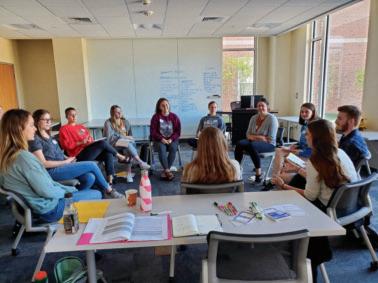
Disclaimer: Jane Smith is a fake name to protect the identity of a student.
According to NBC 4i, an outlet station of NBC News in Columbus, Ohio, the number of sugar relationships has grown significantly over the past few years. A sugar relationship is where an older man or woman, also known as a sugar daddy and mommy, has a relationship with a younger person where the sugar daddies and mommies gift the young partner financially.
Jane Smith, a junior at Ohio University studying accounting analytics and management, is one example of a sugar baby at OU. Smith had just turned 18 when she found her sugar daddy on a sugar relationship website called Seeking Arrangements.
Seeking Arrangements has 20 million members worldwide and 2.5 million of them are college students. According to their website, Seeking Arrangements will give premium access to a user who has an email ending in “.edu.” As of 2019, 552 OU students were signed up on Seeking Arrangements.
Sugar relationships come in all shapes and sizes. The interaction can be purely online, or they can meet in person. Sex can be an option but doesn’t have to be the main goal in a sugar relationship. The dynamic depends on what the sugar daddy and sugar baby agree on.
“My relationship was both online and in person. I told him straight up that there was no sex involved whatsoever,” Smith says. “I had an ‘Only Fans’ (an internet content subscription site) effectively for my sugar daddy. So, I would send him stuff and he would send me money. But we would go on dates and stuff if he wanted an in-person interaction.”
Sometimes, online scammers may pose as a legitimate sugar daddy and try to get money out of potential sugar babies.
According to the Andrews Federal Credit Union website, online dating is a common meeting place for scammers. Catfish, people who pretend to be someone else online, try to create relationships where they can trick the other
participant into sharing personal information so they can try and scam money from them.
Corey Bullock, a sophomore at OU studying business, recently got scammed by a fake sugar daddy online.
“I found my sugar daddy on Seeking Arrangements. I never met my sugar daddy in person, for the most part we only texted about our day, and he would send me money,” Bullock says.
But the relationship didn’t end there for Bullock.
“Eventually, he wanted to meet in-person, and he sent me money through Venmo for gas money. I made up excuses as to why I couldn’t get to him such as not having a car on campus,” he says.
The scammer was insistent on seeing Bullock.
“He sent me more money to borrow a friend’s car and then I told him it broke down. He then got frustrated and said he wanted to meet and help buy me a car so that I could meet up with him. He sent me a check with a couple thousand dollars through email and I was dumb enough to deposit it. Now I am currently dealing with fraud with my bank account because he scammed me.”
Smith has never been scammed and has some advice on how to prevent getting scammed and staying safe.
“I never give out my real name. I always go by a fake name,” Smith says. “To stay safe, I never give them my actual bank account information — I feel like that should be a life advice — so always use something like PayPal or Venmo; no CashApp ‘cause that can be a little sketchy.”
Smith recommends those apps because they usually have ways to fix a scam.
“Then just in general, always have your guard up,” Smith says. “I’ve never gone out somewhere, even when I first met this man, without pepper spray or a taser — just something small but effective.”
Many college students have part-time jobs on campus. For college-aged sugar babies, their relationships may seem just like another part-time
“But overall, just be open to different ideas and be ready to chat and interact with somebody because even though it's not a relationship, I’d still consider them friends in a weird way.”
JANE SMITH SUGAR BABY
job to them. However, there can be a negative stigma around being a sugar baby.
“I don’t even know why there is a stigma to be honest,” Smith says. “There are some sugar babies who like to go out and have sex with people and more power. I just think that it’s not even a real relationship and sugar daddies know that it’s basically like an ‘Only Fans’ at this point. I think most of the people hating on it are guys who are jealous that they aren’t making as much money that sugar babies can make.”
According to Smith, not all sugar baby relationships have to be sexual. Sometimes, a sugar daddy or mommy are mainly in search of companionship or some other type of relationship that favors both parties.
“If you want to be a sugar baby, my first tip would be to be very interactive. People always say act mature for your age, but I’ve never really agreed with that because there’s something about them wanting someone young anyways,” Smith says. “But definitely dress to the nines. Be ready to go out and have table etiquette. But overall, just be open to different ideas and be ready to chat and interact with somebody because even though it’s not a relationship, I’d still consider them friends in a weird way.” b
After more than a year and a half of online and hybrid learning, Ohio University — along with other schools and universities across the nation — has finally returned to some resemblance of normalcy. The presence of the coronavirus is still very much part of university life, but the excitement and nervousness of new freshmen remains the same as they eagerly unpack into dorms and pop in and out of coffee shops on Court Street.
The university’s continued pandemic policies pose an interesting transition for incoming freshmen, many who also experienced a shift from in-person to virtual learning mid-school year. Now, as the first day of school approaches, new bobcats prepare for a hopefully more normal semester of college.
“As the oldest and first kid in my family to go to college I really didn’t know what to expect,” Sophia DiCuirci, a freshman planning to study graphic design says. “So, this all seems normal because I didn’t have expectations in the first place. I definitely didn’t expect masks to be on my packing list for college.”
Due to the delta variant of the coronavirus, OU recently announced the reinstatement of masks for students while indoors and in establishments on Court Street, as well as mandatory vaccinations against the coronavirus for all students, staff and faculty before Nov. 15.
“We were hopeful that people would come back,” Wendy Merb-Brown, the assistant dean for Operations & First-Year and Student Transitions, says. “We didn't think that it would be with a mask. But I feel like the one thing we've learned about COVID is just be ready for change [and] I have so much faith in our students. It's [a] real challenge, but our students are resilient.”
Merb-Brown, along with OU administrative staff, wants to give students the benefit of having the in-person experience in the classroom, and are working to balance the safety and health of the university with in-person activities. MerbBrown says that her office may never go back to the way they conducted student programming before the pandemic and that they’ve adapted to do better.
“We learned a lot about what we can do online and still make a difference and still connect with students,” she says. “That was a wake-up call for us as educators to think of a different way and a more creative way of doing it.”
This means that the university is adjusting to keep the safety of its students and faculty in mind, though it isn’t quite the typical image of college life seen in media and books. “When I pictured my freshman year, I pictured a normal college freshman year for myself with the ability to easily meet new people and make friends, join clubs, go to class and explore the campus and city of Athens,” Riley Long, a freshman studying biology, says. “I saw the light at the end of the tunnel when vaccinations became more and more frequent, but with the new delta variant I can also see this vision slip away.”
hoping when I got to college that the world would be normal again and I’d have all in-person classes, but I truly had no idea what to expect.”
Because of the isolation that comes with learning through a computer screen, rather than in a physical classroom, the mental health of many students has dipped while learning in quarantine. However, one silver lining is that online learning forces students to become more self-reliant instead of dependent on a peer or teacher for their progression in academics. Long agrees, saying that hybrid learning helped her establish a solid schedule with her academics.
“I saw the light at the end of the tunnel when vaccinations became more and more frequent, but with the new delta variant I can also see this vision slip away."
RILEY LONG FRESHMAN BIOLOGY MAJOR
Long, like many newcomers, will still get the benefit of being on campus and the ability to interact with fellow students. But with the threat of the delta variant becoming more prevalent, especially with college-aged students, Long worries that she’ll miss out on her freshman experience and admits that isolation in a world where interaction should occur is a big fear of hers.
“The thing I am looking forward to least, with college, [is] the uncertainty that still lingers from the pandemic, of not knowing what is to come and if things will get shut down again,” Long says. “I was
“It was challenging at first for sure, but as the year went on, I started to really enjoy it and find my rhythm with hybrid learning,” she says. College freshmen may face the challenge of being away from home and having to march to the beat of their own drum, both academically and socially. It is typically the first independant scenario they are approached with as they are becoming adults, so having that extra “tutelage” from the pandemic may serve to help them better adapt to their new environment.
“Being online wasn’t awful itself but my mental health definitely declined with the lack of social interaction,” DiCuirci says.
“I do think that having to take a lot of online classes has prepared me for college a lot, by having to do a lot of teaching myself and having to be more independent.” b




Chocolate chip baked oats are a delicious way to switch up your basic oats into something more flavorful.
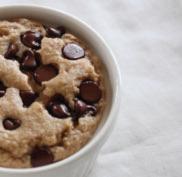
We’ve all grown up with oatmeal and have probably resented it for its simplicity but how about baked oats? Baked oats can be made in a variety of flavors with different ingredients, with anything from blueberry muffin flavor for breakfast to double chocolate baked oats for dessert. Let’s dress up some basic, bland oats into something a little more fun and flavorful with these chocolate chip baked oats!
INGREDIENTS FOR ONE SERVING:
½ cup of oats
1/3 cup of milk of choice
1 tablespoon of maple syrup
1 half of a banana
1 tablespoon of almond butter
½ teaspoon vanilla extract
1 teaspoon baking powder
Any amount of chocolate chips
1 . Blend ingredients in a blender until smooth.
2. Stir in your preferred amount of chocolate chips.
3. Pour into a small baking dish, or oven safe dish, and garnish with more chocolate chips if desired.
4. Bake at 400 F. for 10 minutes. If the middle isn’t cooked all the way through, feel free to add more time until baked to your liking.
Want even more ways to spice up your baked oats? Try these variations!
1. Add protein powder while blending to make “pro-oats.” Great for a post-workout breakfast!
2. Add cocoa powder while blending for rich, chocolate-y oats.
3. Substitute honey for maple syrup or 2 tbsp of applesauce for banana.
4. Add toppings! Throw on a square of chocolate or an Oreo before baking, or for a healthier option, exchange blueberries for chocolate chips, add on fruit as a garnish or top with a spoonful of your choice of nut butter. b
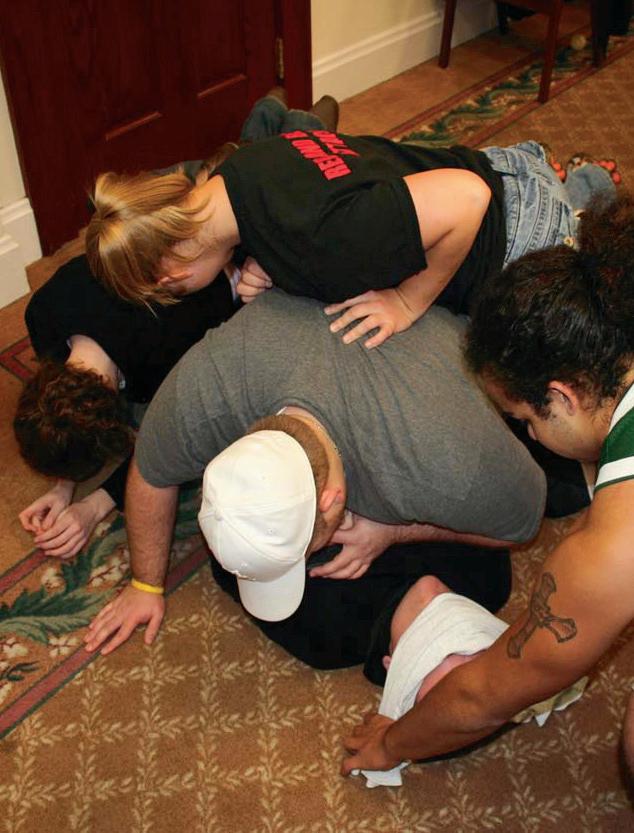
Campus officials and law enforcement share their plan for an active assailant crisis .
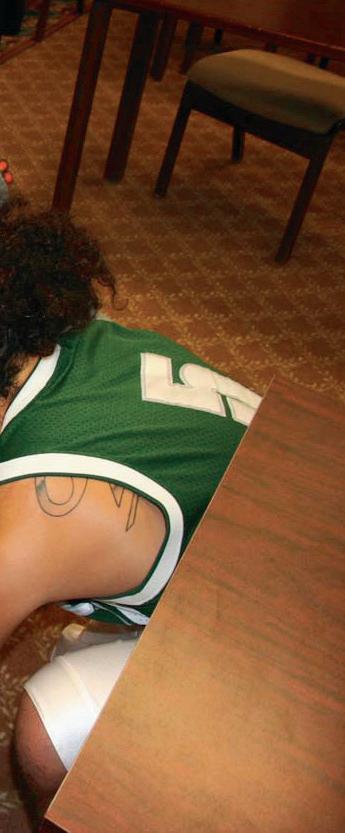 BY ABBY NEFF | CONTRIBUTING WRITER ERIC BOLL | PHOTOS BY ELLIE HABEL | DESIGN BY BROOKE GARRETT
BY ABBY NEFF | CONTRIBUTING WRITER ERIC BOLL | PHOTOS BY ELLIE HABEL | DESIGN BY BROOKE GARRETT
As students return to Ohio University’s campus this fall, many wonder what will be different about the school year. There will be masks, incentives to get vaccinated and maybe the faint feeling of the way things were before. One aspect of pre-pandemic life that has not waned is the threat of gun violence on college campuses.
According to the Gun Violence Archive, an online database that collects daily reports of gun violence incidents in the United States, there were 611 mass shootings in 2020. The Congressional Research Service defines a mass shooting as a firearm incident that kills four or more people.
There were almost 200 more mass shootings that occurred in 2020 than in 2019. The latest data from the GVA reports there have already been 517 mass shootings as of Sept. 23, 2021.This number continues to increase.
Some of the deadliest mass shootings in 2021 include shootings at three salons in Atlanta, Georgia in March, when a white man opened fire and killed eight people, including six women of Asian descent. Another shooting that occurred in March happened at a supermarket in Boulder, Colorado, where the gunman killed 10 people and injured two, including the suspect.
Although the majority of shootings have not occurred at a school or on a university campus this year, the threat continues to concern parents and students. A survey conducted by the Pew Research Center in 2018 found that 57% of teen students they spoke to were concerned about a shooting happening at their school.
OU’s active shooter response plan is available on the “Emergency Responses” website. Students, faculty and parents can find links to several plans, including bomb threats, fire emergencies and civil demonstrations.
According to OU’s active shooter plan, students and faculty should move to a room that can be locked if an assailant is inside or outside the building. If the assailant enters the room, OU advises that it might be possible to negotiate with the shooter. The plan says that overpowering the shooter should be a last resort.
Joe McLaughlin has been working at OU more than 5 years and serves as the vice president of OU’s chapter of the American Association of University Professors (AAUP). He supports the university response plan and cites his faith in Ohio University Police Department (OUPD) as one of the reasons for that belief.
McLaughlin believes that the training offered by the university is a worthwhile experience but believes that professors struggle to find time to attend training.
“The university is, all the time, making more and more demands on faculty time that takes them away from their primary duties of teaching and research,” McLaughlin says. “This training seems like it’s worthwhile and should be a priority, but I suspect many see it as another straw added to an already burdensome load.”
As a previous chair of Faculty Senate, McLaughlin spoke about actions Faculty Senate took against legislation in the
Ohio Senate that would allow concealed carry of firearms on college campuses.
“The campus seemed pretty united against this, and I know many faculty were quite scared about the possibility of students in classes or office hours carrying a gun. Some even told me they would consider ending face-to-face office hours,” McLaughlin says.
The coronavirus pandemic has kept students and faculty from gathering, which means that the campus has mostly been empty. As students and faculty begin to fill up classrooms and campus spaces, local and campus law enforcement are preparing to protect its residents.
For students and faculty to protect themselves, law enforcement offers training for civilians in the case of an active assailant event.
Officer John Stabler has been an instructor with the OUPD for 15 years and teaches active aggressor training courses. Stabler describes OU’s active aggressor training as a mix of multiple popular training courses.
“We have our old ALICE training video online, it stands for Alert, Lockdown, Inform, Counter and Escape,” Stabler says. “That is what we used to do but now ... we have an active aggressor program that covers components of ALICE as well as the CRASE [Civilian Response to Active Shooter Events] program from Texas State University. It allows us to mold our training to better fit our community.”
The Active Law Enforcement Rapid Response Training (ALERRT) Center at Texas State University developed CRASE training for schools, businesses and community members.
According to ALERRT’s website, the training is based on the strategy, “Avoid, Deny, Defend (ADD).” The plan is broken down into three parts. The individual should move away from the threat as soon as possible. If the individual can’t escape the situation, he or she should build barriers and turn off the lights to deny the threat access to the space. Finally, if avoiding and denying the threat does not work, ALERRT says the individual must fight back, and he or she should not fight fairly.
Stabler hopes to see an increase in people going through the training and is working with the university to offer training to more students.
“We don’t want folks to be paranoid, we want them to be informed,” Stabler says. Training sessions are free to the public. Anyone can reach out to OUPD to schedule a training session. Stabler says that around a thousand people went through the active aggressor training in 2019.
In addition to training available to the public for active aggressor incidents, OUPD participates in its own training with Athens Police Department (APD), Athens County Sheriff and the State Highway Patrol to be better prepared for a crisis.
APD Captain Ralph Harvey says despite the suspension of in-person collaboration with OUPD, both forces train for active assailant events together.
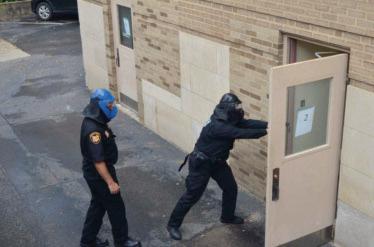
“Officers arrived within seconds of each other and worked their way up the stairs. As they came up out of the stairs, they heard screaming and found a group out in the hallway being loud and playing around,” Stabler says. “They cleared that floor and the rest of the building and came back to them.”
The rest of the operation went by quickly.
“Low and behold, they found it was just them playing around. The noise the caller had heard wasn’t a gunshot. It was a quick and smooth operation,” Stabler says.
Harvey says APD trains officers to respond in several ways, whether that is in a team or individually. If there was an active assailant event on campus, he says OUPD would take the lead.
“The handful of gun violence that we’ve had in Athens in the recent past have been situations that resolve themselves much quicker than a formal callout for SRT or another department,” he says. “But all the departments monitor each other.”
Harvey says the former training for an active assailant was like training for a bank robbery: to contain the incident, wait for specialized units, such as a Special Response Team (SRT) or a Special Weapons and Tactics (SWAT) unit. He says law enforcement were still using that method when he started as an officer in 1995.
Originally, APD trained its officers to respond to active attacks in teams of four. Harvey says that response is no longer the primary method.
“Even that is too slow to somebody that is actively firing a weapon,” Harvey says.
Instead, the first officer who arrives at the scene is expected to assess the best plan of action.
Harvey says an officer can decide to enter an active shooter situation by themself if it is necessary.
Other officers and law enforcement arriving at a scene with an active assailant are expected to form a perimeter around the area. The goal is to prevent more violence from spreading, as well as keeping people from entering an unresolved situation and getting hurt.
The most unique active assailant event Harvey says he has responded to on OU’s campus was behind Tiffin Hall, a dormitory on campus. The assailant was hitting a bench with a battle axe.
“And [the assailant] fled before they [officers] could get him contained or before anyone else arrived,” he says. “So, we actually never did find him.”
Another violent incident that Harvey witnessed in Athens happened when a person was armed with a knife at a bar. He was there with one other officer, and the assailant had injured themselves and one other individual. Harvey tased the assailant.
“There are situations where you would be justified or legally allowed to shoot the individual or use deadly force, but you can’t ... because it’s just too crowded,” he says.
Despite the rare incidents of violence on campus, there is one event every year when state, county and local law enforcement gather in Athens: Halloween weekend. “We also have an advantage in that we work at least once a year with every public safety entity in the county, if not larger,” Harvey says. “Meaning, Halloween is essentially a mass event at some level that we plan for every year.”
In the past, there have been several incidents of violent crime. Harvey says there was a knife attack at a hotel one year, and someone fired a gun in Uptown Athens another year. At one point, law enforcement was arresting over a hundred people in one weekend.
Harvey says the crime and arrest rates during Halloween weekend are “a shadow” of what they once were.
“Halloween is nowhere near what it used to be,” he says.
However, the event is an example of how closely law enforcement agencies work together to keep the community safe.
“We do a lot of coordination, but a lot of it is completely informal,” he says. “The officers and supervisors for OU and Athens work whatever it is out to assist with each other as much as they can.” b

To many in the southeastern Ohio region, the pawpaw is cherished and adored . To Indigenous tribes, it is a reminder of lost food practices .
ARTICLE AND ILLUSTRATIONS BY MCKENNA CHRISTY | DESIGN BY LAINEY DOUGLAS BY JACOB DURBIN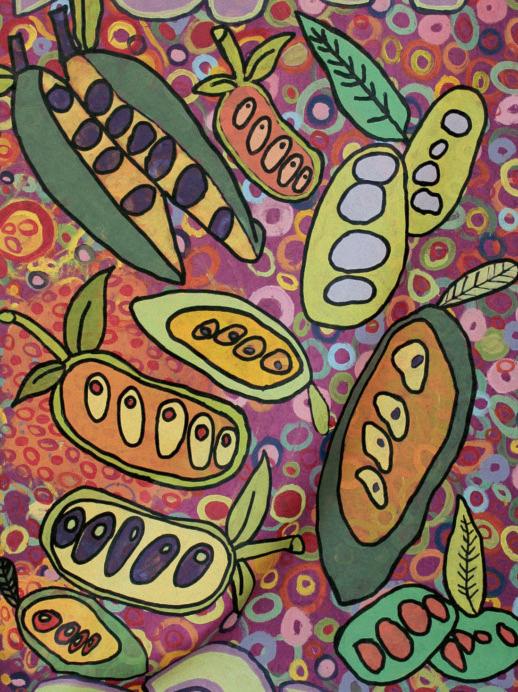

In 25 states East of the Mississippi, a yellowish-green oblong tropical fruit grows in the understories of forest areas near riverbeds. The custardy texture of this unique fruit resembles a taste and flavor described as a combination of mango and banana — a pleasant surprise to many after an initial taste test. The pawpaw, the largest fruit native to North America, is the only tree fruit apart of the Annonaceae family that blossoms in Northern Florida and all the way up in a few regions of Canada.
The pawpaw’s uniqueness may be credited to its addictive tropical flavor and where the fruit calls home, but the history of the pawpaw is rich, ancient and valuable. Ohio History Central records state that the fruit has been around for 30,000 years, and Indigenous Tribes were its first cultivators.
According to the American Indian Health and Diet Project, the pawpaw was an important aspect of the Native American diet for the Shawnee Tribe, which inhabited the Ohio River Valley in the 1600s. The Tribe had a “pawpaw month” detailed in their calendar.
In West Virginia Public Broadcasting reporter Brian Koscho’s article, “Searching for the Pawpaw’s Indigenous Roots,” present day guardian of the Shawnee Tribe, Joel Barnes, explains the Tribe used moon phases to tell time. The “ha’siminikiisfwa” is the word for pawpaw, according to Barnes, and was used to represent the phase indicating the arrival of September.
The pawpaw’s connection to the Shawnee tribe and others has been majorly lost due to the removal of Indigenous peoples from their homelands in 1830, Barnes says to Koscho, who writes that “Barnes’ ancestors were forcibly removed from their Ohio Valley home in Appalachia.”
The Indian Removal Act is responsible for pushing much of the Shawnee tribe out to the West of the Mississippi, and more specifically to Oklahoma, according to the Oklahoma Historical Society.
Indigenous culture and history are commonly erased from culinary practices and discussions of food; however, there are movements working to decolonize food and create food sovereignty for Indigenous peoples.

definition and is always expanding. The Indigenous Food Systems Network says the movement is “a specific policy approach” in which directs attention to the issues surrounding Indigenous people’s “ability to respond to [their] needs for healthy, culturally adapted Indigenous foods.”
“Many of the health issues and inequalities Indigenous peoples face today can be directly linked to colonization, the brutal dispossession of homelands, globalization, migration, and culture and language loss,” Dr. Coté writes. Yet, “Indigenous peoples globally are actively shaping, nurturing and fostering healthy and sustainable communities through their selfdetermination efforts and decolonization strategies.”

To recognize the history of the pawpaw is to acknowledge the food sovereignty movement Native American organizations, Indigenous Tribes and their people started. The pawpaw’s connection to Indigenous culture tells the common story of the effects of colonization: one of the results being the health disparities relating to nutrition. Now, the discussion surrounding food sovereignty becomes deeper.
“‘Indigenizing’” food sovereignty moves beyond a rights-based discourse,” Dr. Coté says. This is done, “…by emphasizing the cultural responsibilities and relationships Indigenous peoples have with their environment and the efforts being made by Indigenous communities to restore these relationships through the revitalization of Indigenous foods and ecological knowledge systems as they assert control over their own foods and practices.”
Celebrations of foods are a means for people to relate to one another and form traditions.
The Ohio Pawpaw Festival, located at Lake Snowden, occurs annually on Sept. 17-19, since the pawpaw fruit ripens during mid-August through September. For Chris Chmiel, founder of the festival and coowner of Integration Acres — the largest pawpaw processor in the world — pawpaws are an everyday attention-grabber.
Dr. Charlotte Coté, associate professor in the department of American Indian Studies at the University of Washington, focuses on Indigenous food traditions. Dr. Coté discusses the purpose of the food sovereignty movement, organized in 1996 by an organization of international farmers called La Via Campesina, in the academic article, “Indigenizing Food Sovereignty. Revitalizing Indigenous Food Practices and Ecological Knowledges in Canada and the United States.”
The food sovereignty movement doesn’t have one
Chmiel tries to make the festival bigger every year. The Ohio Pawpaw Festival has been a tradition for people for 23 years. Awareness of the fruit’s origins in relation to Native American culture is a factor Chmiel considers and addresses.
The East of the River Shawnee Tribe of southeastern Ohio partnered with the festival and were welcomed to be a part of the celebration, Chmiel says.
Back in 2017, the East of the River Shawnee held presentations at the festival; lessons were taught about the Shawnee tribe’s history, traditional music from drums and flutes were

played and other cultural exchanges were shared.
The Tribe did not attend the festival in 2019 for unknown reasons.
Among the various educational aspects the festival offers, there is an abundance of other mini events and activities attendees can embrace and take part in.
“We have artists, [and] we have live music. It’s a real pawpaw festival. It's like every food vendor has to have a pawpaw dish. We have pawpaw trees [and] we encourage the artists to include pawpaw art in their products. So, we really try to make it an authentic event,” Chmiel says.
There are some people who made this pawpaw festival an annual tradition after their first visit. One of those people is Tony Green. Green grew up in the southeastern Ohio area and is an Ohio University alum who only heard of the festival after graduating college.
Green first attended the festival in 2018. Green didn’t know what to expect before he stepped foot onto festival grounds, and nothing could’ve prepared him for the pawpaw filled day.
“I was like, ‘Eh it’s kind of a funny
festival’ and thinking it was gonna be really small, kind of like your typical Ohio festival. Like okay it’s a strawberry fest, there’s really nothing related to strawberries. And when we got there, [I was] like ‘holy smokes,’ they are not kidding, everything is pawpaw,” Green says, reminiscing on his first unforgettable time.
As the pawpaw tree and fruit bring joy and excitement to people, the native fruit persists through environmental challenges. Forest areas are under pressure given the overall conditions of climate change and other special situations, Chmiel says.
“Over the last, say five or six years, there’s been a disease that’s been killing some of the trees and these were like trees that were in forests, like they’ve been alive for decades,” Chmiel says.
The passion for pawpaws runs deep within the community of southeastern Ohio and stretches globally. Despite threatening environmental issues, it’s common for people everywhere to plant their own pawpaw trees. Despite the environmental challenges, pawpaws remain abundant in nature.
“It very much embraces the things I liked about Athens and the Southeast

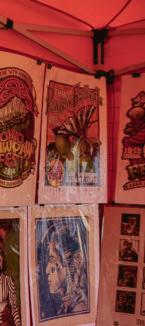
“There’s still a lot of pawpaws around and there’s still good healthy ones. I’m an optimistic person so I try to see like ‘hey, not all the trees are dying.’ So, these ones that aren’t dying, how do we propagate those. Because when you’re hopeless, it sucks,” Chmiel says on overcoming these challenges.
The coronavirus proposed its own challenges for the festival last year. The Ohio Pawpaw Festival was cancelled, and all the work put into the festivities had to be pushed aside for a year.
This year, the coordinators want to ensure the event is safe and protects attendees against the virus along with the variants. On the Ohio Pawpaw Festival website, there’s a recommendation that eventgoers wear masks regardless of their vaccination status.
The pawpaw represents a specialty that connects history to the present day. Without the cultivation, use and protection of the pawpaw by Indigenous tribes, there would be no celebrations today. This strangely shaped and tropical-tasting fruit, which grows in a non-tropical zone, is a reminder of why people celebrate its uniqueness, and the act of doing so brings communities and people together.

“There’s people that are in there 70s and 80s having a lot of fun, but there’s also kids running around so it’s kind of the whole community type feeling. To me it very much embraces the things I liked about Athens and the Southeast Ohio area kind of into one festival,” Green says. b
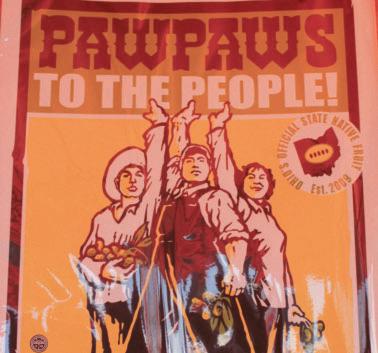


The importance of regional food systems and how we should strengthen them .BY LILY ROBY | PHOTOS BY JACOB DURBIN | DESIGN BY LAINEY DOUGLAS

One bunch of bananas from a big-box chain store like Walmart can travel over a thousand miles from farms in Mexico, Central and South America to reach a customer’s kitchen, according to Business Insider. Commonly grown at massive farms in South and Central America, this fruit is picked and packed into containers kept cool at a steady 56 degrees Fahrenheit to ensure freshness, even though it can take up to four weeks to reach your local Walmart.
The process of growing and shipping food to chain grocery stores is complex and has been perfected by corporations over decades. This has left many accustomed to having almost any food at their fingertips, just a card swipe away. While the promise of fresh strawberries in the dead of winter may sound sweet, the corporate capitalization of America’s palate hasn’t just left regional food systems crumbling but has caused society to stop questioning where their food originates from entirely.
Ohio University’s adjunct associate professor of environmental and plant biology, Theresa Moran, has always been alarmed by this consensus of lack of engagement when it comes to food and its origins. Originally, for the thousands of years humanity had walked the earth, food was chosen based on local availability — what people could grow, raise or find in their region.
Only in the past few centuries have chain groceries and convenience stores become the norm, sourcing their produce, dairy and meats mainly from wholesale farmers. This prioritization of convenience over all else may make things easier, but Moran can’t help but see holes in the system.
“What COVID has shown us is that our food supply chain is extremely brittle and fragile and can be disrupted with a single production plant going offline, or with a single outbreak of disease,” Moran says. “I think the value that has been made the clearest in this COVID time is that we need regional systems, and farmers markets are a very important instrument … because if you build a regional food
system, we don’t have to rely on broccoli coming from California.”
What Moran means by rebuilding a regional food system is that by buying produce, meats, dairy, grains and other groceries from local farmers and producers, consumers are able to know not only exactly what they’re putting into their bodies, but they’re also strengthening their regional food system and, in turn, their local economy.

Think of it like a spider web: if purchases are made frequently between the same local sellers and buyers, the entire region will be stronger, versus if consumers ignore the origins of their food and put their money into wholesale farmers and corporations thousands of miles away.
While there is obviously no sole way to shift society’s taste buds from preferring cheap, mass-produced and hormonepumped chicken over free-range, organically raised local chicken, farmers markets can be a good alternative. Local markets like the Athens Farmers Market (AFM) bring towns together, allow buyers and sellers to connect and meet in real life to discuss their products, send money back into the local economy and redirect community members’ thoughts on food away from convenience and toward the quality and impact of their purchase.
“Going to the farmers market connects you to a person who’s making the food and I think psychologically and sociologically, that is critical because then children become aware of the fact that food comes from a person and there is an actual person involved with delivering food to their table,” Moran says, emphasizes that educating the youth is key in rebuilding our food systems. “Maybe that kid grows up and thinks, ‘Well, I don’t really want to go to Walmart because I don’t know where it came from.’”
But the bottom line, Moran says, is that if people don’t continually ask about the origins of their food, corporations aren’t going to talk. And without paying attention to what we’re eating, we give chain stores like Walmart almost unlimited freedom to capitalize on the food industry and force local farmers to
either lower their prices or sell out their crops to the corporations themselves.
Consumers can also help strengthen our regional food systems by buying from locally owned grocers and restaurants like Kindred Market, the Farmacy, Seamen’s Cardinal Super Market and Jackie O’s Pub and Brewery, who source a majority of their food from within and around Athens. Encouraging those around you to eat locally and think about the origins of food helps, but only goes so far when local farmers can’t even fund their crops without a steady income stream from consumer purchases.
According to Moran, the state of California’s university system is a great example of a massive network of institutions attempting to make change through institutional procurement. After declaring a clear goal to prioritize purchasing foods from within the state of California, the university system has run into issues supporting farmers without offering them long-term commitment.
“What farmers generally do is borrow money to get the seed in the ground and use the profits in order to pay off the loan,” Moran says, explaining the process of funding crops for small-scale farmers, and the importance of farming-related loans, subsidies and grants often provided by the USDA or other government organizations. “If you don’t have access or the ability to do that, you’re not going to be able to, so it’s a long, complicated issue… so we have to have groups of people uniting around this issue and pressuring policy makers in order to create change.”
children and watch their children grow up. It’s nice because they feel better because they can talk to me and ask me questions rather than buy from a box store where they don’t know anything about [the food they’re buying.]”
At the end of the line of vendors, a small booth sits to the side, offering another solution to the pressing issues Athens’ food systems face. Community Food Initiatives (CFI) is a nonprofit focused on providing healthy and affordable foods while sustaining the local economy with a large majority of the produce donated by community gardens, farmer’s market vendors, home gardens and large-scale commercial farms. Reggie Morrow, CFI’s donation station coordinator, explained that while Athens County is a food desert, Athens is still the wealthiest town in the county, so we have to look into places like Nelsonville to truly strengthen our food systems here.

At the AFM Cowdery Farms booth, Larry Cowdery is a fifthgeneration farmer who has been farming for his whole life and selling at the AFM for 21 years and is present every Saturday and Wednesday to sell a wide variety of produce. Most of his product is sold at the market and Athens restaurants.
Previous generations of Cowdery Farms took the wholesale route and traveled a hundred miles about five times a week to ship produce to Columbus, costing the farm drastically when it comes to mileage and presenting more of a disadvantage than an advantage when it comes to selling wholesale. That, along with the connection he gets with the people he sells to, is why Cowdery prefers selling locally.
“I [also] like to sell locally because I get to know the people and they get to know me,” Cowdery says as he stands at his booth, an array of fresh veggies displayed in colorful cartons before him. “I’ve had customers that I’ve had for many, many years and they keep coming back and I get to know their
“You have to make sure that the people who are receiving these foods know what to do with these foods,” Morrow emphasizes. “You come across an eggplant or delicata squash or something where people don’t know what to do with it, they’re not going to take it because they don’t want to waste it.”
Starting in early education, people can be taught how to utilize produce to make healthy meals, according to Morrow. Live Healthy Kids is a program through Live Healthy Appalachia in which second graders go through a year-long cooking and food course. It’s Morrow’s hope that with courses like these, kids will be encouraged to ask for fruits and vegetables, and on top of that know how to make them into a meal.
But ask a farmer what you can do to rebuild our regional food systems, and you won’t be surprised by their response: ask for local food in supermarkets and just eat locally. Sassafras Farm’s Ed Perkins explained that the AFM is limited in its hours, and to seriously grow local food consumption, the food needs to be sold in more grocery stores and people need to realize that local food means that all types of food aren’t available year-round.
“People have the supermarket mentality — you go to a supermarket, and everything is there, all the time, and the farmer’s market and local stuff isn’t like that,” Perkins says. “... So to seriously grow local food, people have to change their mindset and eat more with the seasons. Quit expecting ripe tomatoes in the middle of the winter. But how do you get people to change their mindsets, I don’t know.”
The Athens Farmers Market is open at 1002 E. State St. Wednesdays 9 a.m. to 12 p.m. and Saturdays 9 a.m. to 12 p.m. Visit at athensfarmersmarket.org. b
When leaves hit the ground in autumn, Libby’s Pumpkin Patch comes to life. Owners Kevin and Rachel Lewis opened Libby’s Pumpkin Patch a few short years after selling pumpkins in 2011 when their daughter, Libby, wanted to grow some gourds for fun.
The family ended up with a surplus of pumpkins that year, so they decided to start selling them off the front porch of their barn to those that drove past their farmland located in the foothills of Meigs county.
However, after picking their pumpkins, customers were always left wanting more. It was then that the Lewis’ realized people wanted to have an experience and make memories with their families outdoors. Visitors kept asking the couple if they had more to offer outside of pumpkins such as food, apple cider or hayrides.
After four years of successful gourd sales, the couple decided to form a partnership with Rachel’s brother, Zach Dye, and the company flourished from there.
“What started as a backyard hobby has blossomed into a diverse operation including blackberries, raspberries, apples, peaches, cherries, and of course, pumpkins!” the Libby’s Pumpkin Patch website says. “Our three acre pumpkin patch is full of many varieties of pumpkins. We use cover crops to promote plant health and improve soil quality. We also look for innovative ways to improve crop production while minimizing material and mechanical inputs.”
Many people within the community come to visit Libby’s year after year, but some pumpkin-pickers have traveled hours to come see what is happening at the patch. These visitors, however, do not visit the farm just to buy pumpkins; they are looking for a way to enjoy time with friends and family.
After their visit, many patch-goers enjoy posting about those festive moments online to capture their memories, share them with the world and create an aesthetic social media feed.
In this age of social media, many visitors are looking for photo opportunities, so Libby’s saw the need and now provides many ‘Instagram-able’ locations around the farm. Some of the popular spots are the decorated hay bales, the farmhouse barn and the fan-favorite sunflower field that will feature zinnias and a variety of other flowers next to the patch this year.
Among picking pumpkins and snapping selfies, the patch also offers a wide variety of fun for all ages such as a corn maze, giant slides, yard games and pumpkin-flavored foods.
In consideration of the pandemic, a themed walking trail and picnic park has also been added to accommodate social distancing requirements. Libby’s Pumpkin Patch is looking forward to being fully operational once again this fall.
One of the additional opportunities that Libby’s Pumpkin Patch offers outside of the fall season is the opportunity to use their land as a renting space and venue. The Lewis’ say that when people want to rent a space, they like that they can have it for several days in advance to decorate and plan their event exactly how they’d please.
“Some people like that there is flexibility there,” Rachel says.
Various panhellenic groups from Ohio University and surrounding hold to atmosphere also birthday special the opening Abby the day Abby


surrounding schools have used the barn in the past as a place to hold their Greek Life events. This allows community members to utilize the barn and the surrounding amenities to create an atmosphere for a more personalized experience. The land has also been used for special occasions such as graduation and birthday parties, as well as weddings.
Couples interested in a wedding venue can celebrate their special day at Libby’s anytime throughout the year, apart from the busy fall season in September and October due to the opening of the patch for all visitors. Southeast Ohio locals Abby and Devon Buffington recently held their wedding at the patch in September 2020. “It ended up being the best day and was even more perfect than we could have imagined,” Abby says.
This rustic wedding took place outside on the Lewis’s beautiful farmland and was decorated with wood and earth tones and accented with floral arrangements that featured baby’s breath and violets, which created a natural yet tasteful ambience.
The venue is mostly a blank slate, which allows for a couple or group to decorate and make it exactly as desired. Libby’s provides their barn building and outdoor area complete with tables, chairs and a backlit wall with tulle and fairy lights. For those interested in coming to the patch this fall, Libby’s Pumpkin Patch will open to visitors on Saturday, September 25, and run until the last weekend of October. On Saturday and Sunday, the gates will be open from 11 a.m. to 5 p.m. and
12 p.m. to 5 p.m. on Fridays. Owners Rachel and Kevin begin for the fall season in April and work almost every weekend until the opening date. This ten-year-old endeavor is a proud project for the Lewis’, and they look forward to when autumn comes year after year. “Ten years ago, I had no plans for what it has become now, for sure. It’s fun to see everyone come out and have good family fun together,” Kevin says. b
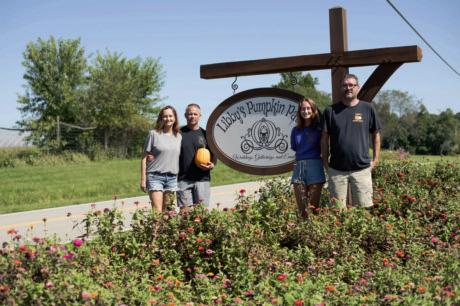

This southeastern Ohio couple runs two full-time businesses: an exercise facility and a sweets shop .
BY JOSIE DONOHUE | PHOTOS PROVIDED BY JESSICA BREWER | DESIGN BY RACHEL RECTORSometimes, the ingredients to the recipe for success don’t seem to go hand in hand. For Chase and Madi Jenkins, their success stems from owning two seemingly opposite small businesses: a local gym and an e-commerce cookie company.
The Jenkins decided to quit their regular day jobs and pursue their dreams of opening their own small businesses.These high school sweethearts turned business partners started thinking about opening a gym in Southeast Ohio after finding that Meigs County did not have access to health programs close to home.
This news motivated Chase to take up a full-time position in 2019 as the small business owner of Uplift Fitness located on Main Street in Pomeroy, Ohio, overlooking the Ohio River.
At Uplift, they strive to be “counter-fitness culture” to create an environment where anyone can feel welcome at any stage of their personal health journey. The Jenkins' have also curated many resources for their members outside of the physical facility on their website, upliftfitnessohio.com, such as recipes, classes, online workshops, educational programs and much more.
“We’re always adding and adding because we want to build value. As we go along, the more we interact with people, and we see more needs,” Chase says.
The gym offers two different membership packages: one that provides 24/7 access and one that allows fitness-goers to visit the gym during regularly staffed hours. When in the gym, personal trainers are there to assist and welcome members in with a smile and a friendly face.
Cole Durst, a junior at Ohio University studying exercise physiology, has been going to Uplift Fitness for two and a half years now due to its welcoming environment and opportunity to work with a personal trainer. Durst is currently set to soon become a personal trainer himself at Uplift and looks forward to helping people in the community.
“Chase and Madi have been tremendous to work with. They definitely give it their all in everything they do and I’m excited to see how much more they accomplish,” Durst says.
The goal for Uplift Fitness is to create an atmosphere where members can feel comfortable and positive about their
well-being while also getting stronger not only physically, but mentally.
The Jenkins' co-run the gym, but while Chase focuses on fitness, Madi has tuned into her sweet side.
Mad Batter Cookie Co. was an idea that came to Madi after she was tasked with creating a business plan for her marketing capstone project at the University of Rio Grande in 2019. She was inspired after she started baking and selling sweets to family and friends in the community as a side hustle to make some extra cash.
“I ended up using that business to make an actual business plan and I was like ‘Woah, this is kinda legit—I could use it,’” Madi says.
Post-graduation, Madi realized a routine desk job was not for her, and after some test runs (and taste testing), Mad Batter Cookie Co. blossomed into a full-time e-commerce business in February 2020.
After placing an order online at madbattercookie.com, these massive, freshly baked cookies are shipped to you. According to their FAQ section on the website, “Orders Monday-Sunday night are baked the following week. Cookies are baked fresh Monday-Wednesday each week and mailed 24 hours from out of the oven. We will send you an email with a tracking number when shipped.”
These sweet treats go above and beyond the average store-bought cookies. Flavors like Brownie Batter, Classic
Chocolate Chip and Sugar Mama (which is a sprinkle coated sugar cookie) grace the menu, but there have also been unique flavors of month such as Strawberry Pop Tart, Margarita and Funky Monkey.
Mad Batter Cookie Co. strives to create cookies that gives customers a nostalgia element that makes them feel like a kid at grandma’s house again.
“Those flavors that I would have loved as a kid is what I want to put into a cookie,” Madi says.
The best seller is Peanut Buddy, which is a peanut flavored cookie stuffed with peanut butter filling and topped with Reese’s pieces. These locally famous sugary snacks have been shipped nationwide from the East to the West Coast and the shop continues to grow weekly.
On top of maintaining both businesses, Madi and Chase also co-run a private marketing agency on the side where they provide resources, support and insight that small business owners can use to start growing their own businesses.
These small business owners’ biggest piece of advice for those interested in starting their own shop is to work backward. Rather than starting from square one, they advise that it is better if one imagines the end target and then designs a plan to work toward that goal.
“You don’t have to have money; you don’t have to have a master’s degree,” Chase says. “You just need a community and the right people doing the right things. We’ll make that happen.” b

Some of the Mad Batter Cookies made by Madison Jenkins. You can find where they will be on Instagram @madbatter_cookieco
Social media can give people a platform where they can materialize their ideas by creating and pursuing online business ventures. Baylee Wolfe, an Ohio University sophomore studying energy engineering and economics, formed her self-made business, OU Upcycle, with a focus on sustainable and ethical shopping, as well as a focus on bettering the planet.
In August 2020, Wolfe decided she wanted to be a part of something bigger than herself.
“I knew I wanted to contribute to my environment,” Wolfe says. “This led me to be inspired by the multiple Instagram accounts that sell thrifted clothing and promote sustainable fashion. In order to become more connected with my classmates at Ohio University, I decided to make my account geared toward Bobcat apparel.”
Most of the pieces that Wolfe sells are thrifted locally. She encourages a cycle of repurchasing and reusing OU apparel and promoting an environmentally friendly Bobcat community. She posts items on her Instagram on first come, first served basis, and people interested in purchasing can direct message her to secure an item.
Wolfe’s Venmo account is listed in the OU Upcycle Instagram account biography along with the shipping fee and #ouupavailable, which is a hashtag buyers can visit to easily see which items are still up for grabs.
The first few items that Wolfe sold were clothing passed down from family members who are Bobcat alums. Occasionally, she also buys gear from graduating Bobcats to resell.
“That is one of my favorite [aspects] of owning my business, because I get to directly interact with people that have the same mission as me — reducing waste and making a difference,” says Wolfe. “After people Venmo me, I set up a time to meet them. I prefer to meet people on campus or outside my favorite coffee shop, Donkey Coffee, although I will ship to students that cannot be on campus. This past year I shipped approximately 30 packages to students all over that could not be on campus due to COVID.”
One OU student, Hannah Beckman, a sophomore studying communication sciences and disorders, purchased from the business in August.
“I’ve been following OU Upcycle for some time now. It’s a great place to get cheap Bobcat gear,” Beckman says. “The items go pretty fast though, so you have to be ready to claim what you want. I got a T-shirt for only eight dollars which is like more than half the amount of what Bobcat T-shirts cost elsewhere.”
On OU Upcycles’ Instagram, Wolfe encourages people to try sustainable shopping. Sustainable shopping is defined by GreenDreamer.com as, “... clothing that is designed, manufactured, distributed, and used in ways that are environmentally friendly.”
Thrifting is one example of clothing being used in an environmentally friendly way because it can keep clothing from being discarded and can reduce the demand for new products. Just about anyone can start participating in sustainable shopping, whether they start shopping at thrift stores, check out online upcycling businesses such as OU Upcycle or adjust their shopping habits.
“Sustainable shopping starts small,” Wolfe says. “Most people skip straight into the mindset that you must buy secondhand in order to ship sustainably. Habits I have adopted [are] avoiding synthetic fibers and reusing old clothing, whether this consists of recycling an old shirt into a pillowcase, giving it to a friend or donating it, it is important to be aware of where your old clothes are going.”
This social media endeavor has allowed Wolfe to encourage sustainable and ethical shopping while also making a profit and connecting with other OU students.
“It’s really important to keep in touch with your followers and provide timely feedback,” she says. “I have also had to face many responsibilities that get in the way of my own plans sometimes. In the end, just take a risk and start your own small business. The beginning is the scariest part, but I took a leap, and it has opened the door to many opportunities!”
Visit OU Upcycle on Instagram @ou.upcycle. b
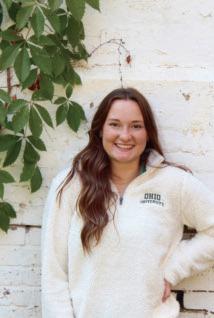

Although they are an art director with Backdrop Magazine, Brooke Garrett also finds interest as a digital photographer. Last fall, when the “Ghost Photoshoot” was a trend on TikTok, Brooke called up their friend Peyton, bought some white bedsheets and took photos of Pey around the trails behind The Ridges. They probably took back a ghost with them, but it was worth it!



Check out these entertaining and educational events on campus this semester.
BY MIA WALSHOCT. 10, 4 P.M.
The College of Fine Arts is hosting pianist, Qing Jiang, as she performs her recital “Dreamed Landscapes” Glidden Hall at 4 p.m. With degrees from Arizona State University, Juilliard and New England Conservatory, Jiang is a seasoned performer, teacher and advocate for the arts. Tickets are free at the door.
OCT. 19, 4 P.M. - 5:30 P.M.
Hosted by the Women’s Center, this workshop designed to aid women who continually undersell themselves and give a space for self-reflection and growth. It will also talk about societal expectations of women through verbal inflections, body language, and more. Participation is encouraged. The virtual event requires registration by emailing womenscenter@ohio.edu.

NOV. 5, 7 P.M. - 10 P.M.
The Black Student Communication Caucus will host a poetry slam for students to showcase their work. Located at Baker Theater, the event will be held from 7 p.m.-10 p.m. Admission is $3.
NOV. 17
Head over to Heritage Hall on November 17 because the OB/GYN Club is hosting a Period Supply Donation Drive.
NOV. 22, 5:30 P.M. - 7 P.M.
The Van Gogh Affect showcases photographers that have been influenced by Van Gogh. Located in the Kennedy Musuem of Art from 5:30 p.m.-7 p.m., admission is free.